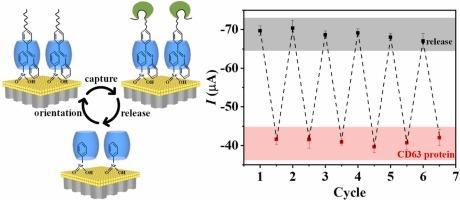基于主-客体复合物的光致纳米孔膜用于外泌体膜蛋白的电化学定量
IF 3.7
1区 化学
Q1 CHEMISTRY, ANALYTICAL
引用次数: 0
摘要
外泌体膜蛋白由于其独特的细胞功能和与癌症类型密切相关而起着至关重要的作用。在这里,金纳米粒子被原位组装在纳米孔膜(NM)表面,形成网状的金包覆纳米孔膜(netAu-NM)。得益于金层的高表面积和多孔结构,所制备的netAu-NM通过纳米通道表现出增强的离子传输。基于瓜bbbbil、苯二烯酸和偶氮苯接枝适配体之间的主客体相互作用,构建了一个超分子组装体。苯二烯酸通过Au-Se键将主-客体复合物固定在netAu层上。在netAu-NM上定向的适体可以特异性识别和捕获外泌体表面的CD63蛋白。利用电流-电位(I-V)响应来监测纳米表面发生的适体-靶相互作用。在此基础上,该传感方法可实现CD63蛋白的定量测定,检测限为3.5 ng·mL−1。此外,在紫外光照射下,适体-靶标生物偶联物可以被释放,这为随后固定新的适体提供了条件。该策略可用于捕获和检测外泌体。膜的可重复使用性为其他疾病生物标志物的检测提供了一个可持续和经济的平台。本文章由计算机程序翻译,如有差异,请以英文原文为准。

Light-actuated nanoporous membrane based on host-guest complex for electrochemical quantification of exosomal membrane protein
Exosomal membrane protein plays a crucial role due to its distinctive cellular functions and close association with cancer types. Here, gold nanoparticles were in situ assembled on the surface of a nanoporous membrane (NM), forming net-like gold-coated nanoporous membrane (netAu-NM). Benefiting from the high surface area and porous architecture of the gold layer, the prepared netAu-NM exhibited enhanced ion transport through the nanochannels of the NM. A supramolecular assembly has been constructed based on the host-guest interaction between cucurbit[8]uril, benzeneseleninic acid as well as azobenzene-grafted aptamer. Benzeneseleninic acid was applied to anchor the host-guest complex onto the netAu layer via Au–Se bonds. The aptamer oriented on the netAu-NM can specifically recognize and capture CD63 protein on the exosomal surface. Current-potential (I-V) response was utilized to monitor the aptamer-target interaction that occurred on the surface of NM. On this basis, the sensing method could achieve quantitative determination of CD63 protein, with a limit of detection of 3.5 ng·mL−1. Moreover, the aptamer-target bioconjugate could be released under ultraviolet light irradiation, which allowed for the subsequent immobilization of new aptamer. This strategy can be employed for the capture and detection of exosomes. The reusability of the membranes provided a sustainable and cost-effective platform for the detection of other disease biomarkers.
求助全文
通过发布文献求助,成功后即可免费获取论文全文。
去求助
来源期刊

Sensors and Actuators B: Chemical
工程技术-电化学
CiteScore
14.60
自引率
11.90%
发文量
1776
审稿时长
3.2 months
期刊介绍:
Sensors & Actuators, B: Chemical is an international journal focused on the research and development of chemical transducers. It covers chemical sensors and biosensors, chemical actuators, and analytical microsystems. The journal is interdisciplinary, aiming to publish original works showcasing substantial advancements beyond the current state of the art in these fields, with practical applicability to solving meaningful analytical problems. Review articles are accepted by invitation from an Editor of the journal.
 求助内容:
求助内容: 应助结果提醒方式:
应助结果提醒方式:


